Columbus, Ohio is by far the best performing city in Ohio. In a state that has become a byword for the challenges and pain of de-industrialization, Columbus is a clear standout, with strong economic and population growth.
A lot of the analysis of what makes Columbus different from Cleveland, Toledo, Dayton, Youngstown, and even Cincinnati often starts out by noting all the advantages Columbus had. It is the state capital. Ohio State University is there. It was not a traditional heavy manufacturing center (less true than you might think), and so did not have that legacy to overcome.
But what strikes me about Columbus is not all the advantages it has, but rather the handicaps it has when compared to other Midwestern standouts like the Twin Cities:
- The Columbus metro area has only 15% of the state’s population, and thus does not form a significant voting block in the state house. Compare to say the Twin Cities or Chicago.
- It is one of three major cities in Ohio (Cleveland and Cincinnati being the others), and is the smallest of them. There are also a number of mid-sized cities like Toledo, Youngstown, and Dayton. This makes Ohio an urban-friendly state, but also makes the competition for state resources intense. There is no other Midwestern state with anything like this.
- Cincinnati and Cleveland both came of age early and were giants of their ages, which endowed them with an incredible built environment legacy and many absolute top quality high culture institutions. Since Columbus lagged, and since Ohio already had these things through Cincy and Cleveland, Columbus is comparatively lacking in both regards. It is especially notable that Columbus’ high culture institutions are very weak compared to most Midwestern cities.
- Columbus does not have any of the top three professional sports team, again, probably because of the Cincy/Cleveland factor. People who think pro sports are overly key to urban success have to be able to explain away the Columbus example. It does have NHL and MLS franchises.
- Columbus has a comparatively weak central business district. It has the typical office buildings and such to be sure. But its downtown mall, City Center, is closed and will be demolished. It is not a major convention destination. Nor is downtown a major entertainment district for the city.
So you can see that there are a number of structural weaknesses working against Columbus. But the one that I really think is the kicker is the name “Columbus” itself. It is just very generic and has no brand recognition. Columbus is probably the biggest city in America where the state is almost always given along with the city, i.e., “Columbus, Ohio” versus “Cincinnati”. Say Detroit, Milwaukee, Indianapolis, St. Louis and by themselves people know where you are talking about at at least something about it. But say Columbus and people probably think of a town named Columbus in their own state, like Columbus, Indiana or Columbus, Georgia. This is one area the lack of pro sports probably hurts the city badly, since cities with major league franchises are constantly getting their name on TV. (I have long endorsed viewing pro sports subsidies as basically a naming rights sponsorship, where the city pays to put its name on the team for marketing exposure. How much would it cost to buy all those TV impressions? A lot more than the cost of the team.) Heck, type “Columbus” into Wikipedia and you get back a disambiguation page.
In addition to just having a generic name shared with cities in various states, there is really nothing that would put Columbus on the mental map of the world. Louisville has the Kentucky Derby. No matter what else people may or may not know about Louisville, everyone knows the Derby and that it is in Louisville. It’s a similar story for the Indianapolis 500. But Columbus? Nothing.
I caused some pain for myself on a Columbus message board by suggesting that outside the United States, especially in Europe, Columbus, Indiana probably has better brand recognition than Columbus, Ohio and that among a certain social set if you just said, “Columbus”, the Indiana town is what would come to mind. This is because Columbus, Indiana has one of the world’s most important collections of modernist architecture by a who’s who of key architects. (It is an absolute must visit, incidentally, and be sure to sign up for the bus tour at the visitor’s center). It has an international reputation for this.
So I think in looking at Columbus, you need to be able to see its success in terms of the big headwinds the city faces in some respects. This renders its performance all the more impressive. Consider:
- The Columbus metro population is growing at a rate of 1.1% per year, which exceeds the national average. It is the second fastest growing large city in the Midwest after Indianapolis. What’s more, its growth held steady last year in a time when most cities suffered declining performance. Indy’s growth rate has eroded the last two years running, so if trends continue, Columbus will be #1 in short order. The Columbus region is adding people at a healthy run rate of 200,000 per decade.
- Columbus has net in-migration, including the rarity of domestic in-migration.
- Columbus has been adding jobs at one of the strongest rates in the Midwest. While its economy has taken a hit recently like all others, it has held up much better than the Midwest. Its unemployment rate of 8.1% compares favorably to other traditionally strong Midwest economies like Indianapolis (8.7%), Minneapolis (8.4%) and Kansas City (8.2%)
Columbus’ economy is powered by many of the same things that have led other Midwest peer cities. Columbus has a very low cost of living, an increasing array of urban amenities, and very high quality of life with regards to such measures as traffic congestion. It does also have the benefit of Ohio State University, the largest university campus in the country, which has the effect of almost making Columbus America’s biggest college town. Normally a school wouldn’t make as big a splash in a city this size, but OSU is so huge, it does. This has many positive impacts such as skewing the population younger, driving international migration, increasing college degree attainment rates, and enabling research oriented spinoffs. (It probably does act as a drag on labor force as a percentage of population, however).
Columbus also seems to have benefited from longstanding enlightened leadership. Back in the 1950’s or so, one of their mayors made a key decision. He refused to extend water service to places that did not agree to be annexed. Thus Columbus was able to expand geographically where most Midwestern cities got hemmed in. So while it does not have a city-county merger in effect, Columbus takes up a huge amount of the county, with a population in the city proper of over 700,000 people. Ohio has very favorable annexation laws for cities that control utilities. If you get utility service from a city, you can’t stop them from annexing you – and you can annex across county lines, something that Columbus has already done. While it now does have cities like Dublin ringing it in some respects, there seems to be a recognition that there needs to be room for the city to continue to grow, and from what I’ve seen, annexation boundary agreements with suburbs continue to provide more or less unlimited possibilities for Columbus to continue expanding.
The corporate community is robust and engaged. Columbus seems to have a very strong economic development mindset, and a pro-business attitude. The local corporate community has been very active in things like the development of the Arena District, and has pumped a lot of money into the downtown. There can be complaints, probably with some degree of legitimacy, that development policies are overly corporate driven, but this is true everywhere. Columbus has also notably maintained a large white collar work force.
The government and citizen base seems to be supportive of fairly progressive public policies. I noted recently how citizens of the city have routinely voted for bond levies to fund various civic improvements. Even in this recession, there was just a vote for a levy that is partially to maintain operations, but also partially to expand the parks. Like many cities, Columbus has a lot of overgrown country roads that haven’t been upgraded, but it is trying. Last year Columbus spend $50 million on adding new sidewalks, for example. There have been other bond issues and many of them are focused on things like sidewalks and other projects to improve the quality of the overall city’s general infrastructure, not a handful of splashy mega-projects. As I’ve long said, the mark of a great city is in how it treats its ordinary spaces, not its special ones. Every small town in America makes its Main Street look nice. But the ordinary street is much more important. Columbus seems to get that.
The one thing that has failed in Columbus is light rail. It was voted down. Actually, I think that’s probably a good thing since while improved transit is certainly needed there, a very expensive light rail system probably isn’t a fit for Columbus.
Columbus, like most cities, has an urban core that has many challenges. There are a lot of areas of the old city of Columbus that are as decayed as any other place. But Columbus also has a lot of urban gems in its central city as well. German Village is one of the top historic districts in the United States. It is truly incredible and a must visit. While the downtown isn’t that exciting, areas like the Short North and the entire continuous strip of urbanized development north along High St. through the University campus up to Worthington is impressive. There are a number of smaller Franklin County suburbs that are super-cool “old school old money” type places in their appearnce. Newer places like Dublin are starting to turn it on.
So what does Columbus need to do moving forward?
1. It needs to strengthen its brand. I wrote a lot about strengthening the brand of Indianapolis in this blog, but that city is one I know intimately. I don’t know Columbus well enough to judge what its essential character might be yet, but ultimately a real brand image needs to spring from the native soil. Columbus can’t be a world class city unless it is a world class Columbus. Great cities, like great wines, have to express their terroir. Trying to graft coolness onto a place apart from its essential character only looks pathetic. I think Columbus is still stuck in a insecure phase where it is engaging in braggadocio to make itself seem like it is one of the cool upperclassmen. The best example here is the city calling itself “The Indie Arts Capital of the World”. There is actually some goodness in this. I noted the city’s relatively weak high culture institutions, so focusing on indie arts makes sense. But is this brand likely to play in Chicago? I don’t think so. Nor do I think it works as a aspirational statement since it seems at odds with local character and difficult to achieve. This won’t be easy. The name Columbus itself is a bit of a millstone as I noted. But I think it can be done. It’s going to take a lot of digging deep and working hard, and finding an inner confidence in what Columbus is as a city.
2. Infrastructure is a problem. Columbus is growing and needs to expand its infrastructure to keep up and also improve and maintain its legacy infrastructure. The problem is that key portions of Columbus’ legacy infrastructure require very expensive upgrades that will likely suck up all available funds. This will hurt it if something creative isn’t found. For example, ODOT is going to spend over a billion dollars reconstructing part of the inner loop downtown. That is desperately needed since the road is unsafe, but is unlikely to add to Columbus’ competitive advantage as a city. And that’s a billion that can’t be spent on other things. Some locals want to put caps on the freeway to mitigate the “noose effect” it has on downtown. These are very expensive and have been considered too costly to include. This ought to be reconsidered. Yes, it won’t be cheap. But cutting out every “value added” element from a project to keep the cost down means you could ultimately end up with still an ultra-expensive project, but one that has little real boost for the city. If you’ve got lemons, you need to make lemonade. If you’re going to hold your nose and fix a problem like this, you might as well pinch a little harder and do the job right so that you get some actual value out of it.
3. Improve the quality of urban design. Columbus isn’t bad, but its built environment is rather generic. It needs to improve the quality of its architecture and public space, and what’s more use design as a way of expressing its brand. This is a huge opportunity area for cities like Columbus to create a differentiated physical environment at modest incremental cost. It seems to be something that doesn’t register with people, however. Indianapolis, as I’ve noted, has some simply superb examples of design in a handful of locations – but refuses to do anything with them. I am utterly befuddled by this. Even Chicago is backsliding on this front. It’s a big opportunity area for Columbus.
4. Tune-up the economic development engine. Columbus is doing well here – it’s hard to argue with the results. But I think a pro-active scan to find some specific niches where Columbus can create sustainable competitive advantage and get the benefits of being a first mover are would be good to do. I think the future is about micro-clusters made up of many small and medium sized businesses that in aggregate will add up to what say a single major HQ or factory might have had. Only looking at general mega-clustures like life sciences is not enough. Also, OSU brings huge numbers of outsiders to the area for four years. They probably had a great time. How can the city turn the OSU university alumni network into an urban alumni network?
On the whole, I think Columbus is rocking and rolling. Because of its weak name recognition and the fact that it is in Ohio, I think it flies almost completely under the radar. But this an impressive city and one that is arguably the best positioned of any Midwestern metro to really prosper in the 21st century economy. For those of you who haven’t been to Columbus, I strongly suggest a visit. This is not a Cincinnati or Chicago like place where you will be immediately wowed by the coolness of the built environment. But I think it will surprise you nevertheless. Before you go, drop by Columbus Underground and let the crew there tell you what you ought to see and do.
I don’t have pictures of all of the cool areas of Columbus, but here are a few samples for you.
Some scenes from German Village.
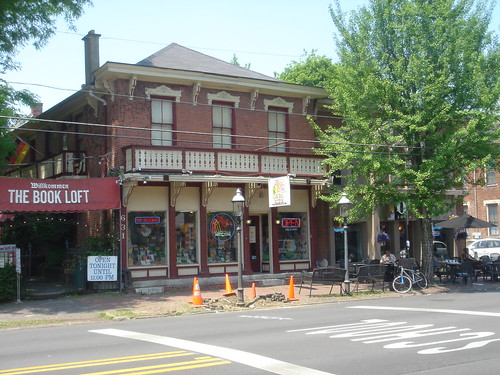


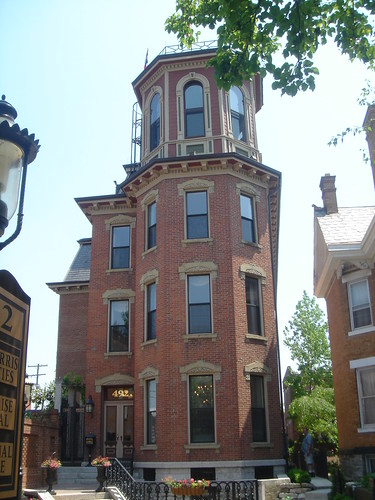
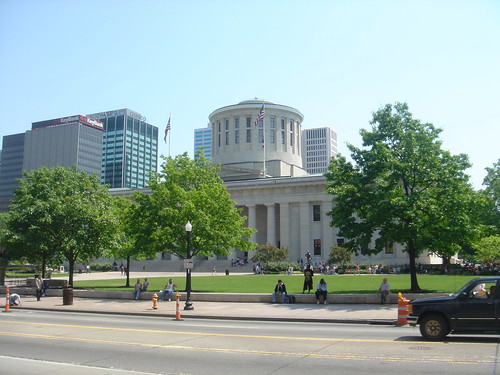

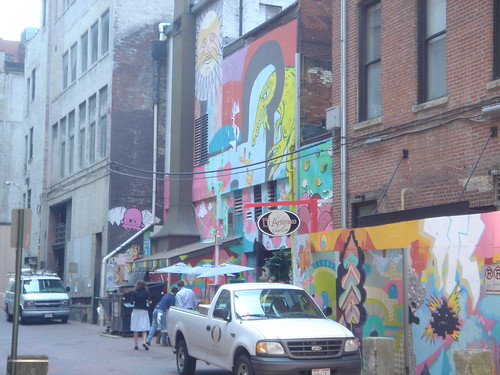
The downtown arena is named for Nationwide Insurance, which is the prime mover behind much of the downtown redevelopment.

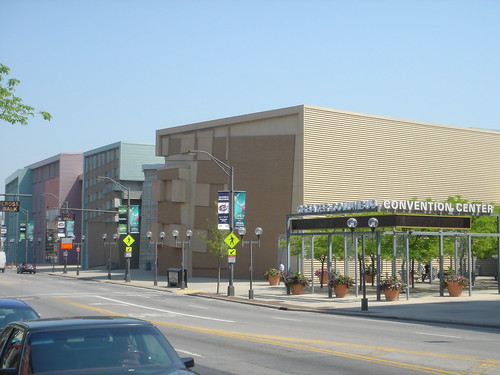


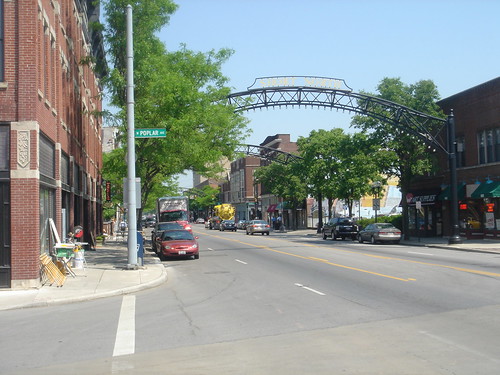
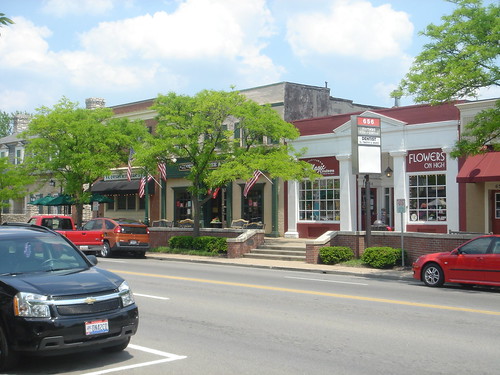
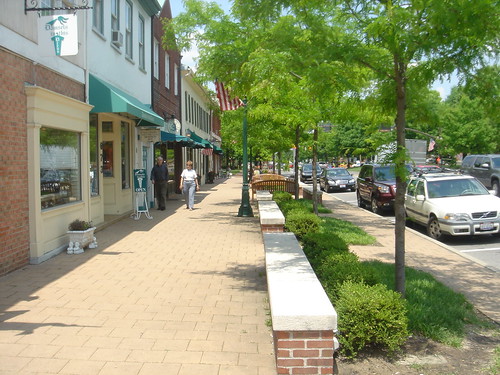
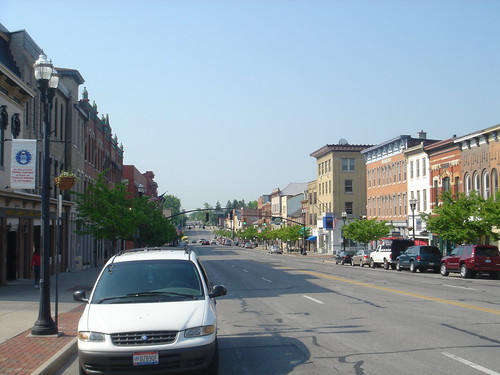
The Brand Promise of Indianapolis
Our Product is Better Than Our Brand
Louisville: Vice City
Thoughts on Urban Design that are relevant to Columbus:
15 Quick, Easy, and Cheap Ways to Make a Big Urban Design Impact in Indianapolis
This post originally ran on May 17, 2009.
Portland, OR has to be the largest city in America that still must include the state letters behind it. Portland’s MSA is approximately 300,000 people larger than Columbus’. This is because of Portland, Maine, and for Columbus it is because of the wide array of Columbus-named cities around the country. I’m not sure either will be able to shed this, ever…but Portland does seem to be identifying itself better even though AP style will probably still continue to require the state designation behind its city name.
While not in the US, Vancouver BC has similar issues. And unlike the situation with the two Portlands, which are on opposite coasts, the two Vancouvers are only 300 miles apart; a sense of endless confusion for visitors to the Northwest.
(This is one reason why residents of the Washington city, and those in the Portland metro area in general, refer to Vancouver, WA as “The Couv”–a term which doesn’t refer to the Canadian city, AFICT.
That’s a great assessment of my hometown. I almost never say I’m from Columbus, Ohio, though- most of the time when I say I’m from Columbus, people know which Columbus I’m talking about. Granted, I’ve lived in Ohio most of my life, but even when I was in DC or when I’m talking to people who aren’t from Ohio, people know which Columbus I mean without having to add Ohio. It’s the only Columbus that is a state capital, which I think helps with the identification issue. I do think Columbus’s largest identifier is OSU. Most people know about OSU, even if they’re not familiar with Columbus, or even Ohio in general. Perhaps that’s where the best opportunity for city branding comes in.
I also agree with your light rail assessment, even though it pains me to say it (I love light rail). But Columbus does definitely need to do something about the transit system. It works well if you only need it around downtown or on High Street, but if you live in one of the further suburbs (which is where I grew up, mostly), it fails miserably. I don’t think the Columbus area will ever really be considered a “real” urban area until you don’t have to drive everywhere to get anywhere.
Still think Indianapolis will be the breakout star of the Midwest for the next 20+ years. All the right elements are in place for the city to take off, similarly to Atlanta in the 70s. Will not get that big, surely, but will certainly continue to thrive, along with Columbus and Kansas City.
Thanks for the comments.
MoeJoe, here is my take on Indy vs. Cbus, for what it is worth. For Columbus, I think its outcome distribution is a normal curve, with a mid-point higher than the average city. I think the most likely scenario for Columbus is pretty good.
For Indy, I think the potential is higher than Columbus. But I see Indy as either being really good, or having its momentum flame out. I hope for the best, of course. If Indy hits its potential, then I believe it will outperform Columbus.
Kim, here in Indy, it’s absolutely necessary to say that my hometown is Columbus (pause) Ohio. To make matters even more confusing, it’s also necessary to say that I’ve also lived and worked in Columbus (pause) Indiana.
Aaron, Columbus does have a professional football team, one that could probably beat the Bengals and Browns on a regular basis. And they put more people in the stands than either NFL team. There is an “Ohio State Nation” out there already.
Hey Kids, I know what we can do!
Let’s move the state capital to Cleveland!
Let’s move OSU to Toledo!
Enough said…
It should be noted that the photo captioned “Restaurants in the vicinity” is actually that of the High St cap over I-670 recently built to connect the Arena District and convention center to the Short North. Nice illustration of the earlier point about caps on the upcoming I-70/I-71 project downtown.
While the Buckeyes are a college football power, and both the Browns and Bengals have been bottom-tier NFL squads of late…there’s still no way that any NFL squad doesn’t crush any NCAA team should they meat.
The difference in skill between the pros and the NCAA is that large. Male athletes reach their physical peaks in their late 20s, pro players likewise have had time to hone their skills for several more years, and the NFL is composed of the NCAA’s best of the best.
Suggesting that OSU could beat an NFL team is just plain wrong. 🙂
I dont know if the photos of Columbus’s suburbs are typical.But its interesting that they dont look much different then the photos of the city of Columbus.
Judging from the photos the suburbs there have done a nice job of mixing urban and suburban.Those shopping strips look a ot nicer then the usual ugly suburban strip malls that im familiar with. Im curuios as to how common they are.Or whther the ones in the photos are atypical.
Great post on a place you obviously know well.
Re the name: When was the last time a major US city changed its name? Globally, this seems to happen only in the context of literal or cultural warfare (Saigon->Ho Chi Minh, Bombay->Mumbai). Obviously one reason not to do this is the fear that even city names will succumb to the lure of corporate sponsorship. But it’s a huge advantage to have a unique city name that doesn’t need a clarifier. It suggests that your city is claiming a place in the world, not just a place in your local context.
To this end, as a blogger who deals a lot with these cities, I adamantly refuse to write or say ‘Portland, Oregon.’ When I say “Portland” I mean “the largest city in the world called Portland, and the only one with global visibility and relevance.” For the same reason, I’d refer to “Vancouver, BC” only when in the Portland area, where Vancouver, Washington is located. Otherwise, I insistently say just “Vancouver,” and have yet to be asked for clarification of the term.
Having said that, there would be easy solutions if any city wanted to go to the trouble to disambiguate itself. I’d be happy with renaming Portland, Oregon as New Portland if it would eliminate the problem, though by just saying “Portland” I’m really insisting that this is the smaller city’s problem.
Vancouver, Washington could easily rename itself Fort Vancouver. (The application of the name “Vancouver” to a city on the Columbia River is particularly absurd, because Captain George Vancouver famously failed to notice the mouth of the Columbia as he explored up the west coast. The city name actually comes from Fort Vancouver on the same site.)
Columbus is enough bigger than its peers that a conscious campaign of refusing to say “, Ohio” after the name might break through. Columbus, Indiana could call itself “Old Columbus” which might be better brand anyway given their offering.
Re the city boundaries: The inclusion of a lot of suburbia will be a big advantage for Columbus when they decide to use it.
Core cities that have annexed large parts of their suburban fabric are more conservative than they would be otherwise, but they also speak for their region in a much stronger voice. For example, Los Angeles Mayor Antonio Villaraigosa is understood as speaking for “greater Los Angeles” as he lobbies for accelerted funding of the region’s rail transit plan. The fact that the plan is for the entire county while he represents the City just doesn’t matter, because the City of Los Angeles is big enough, diverse enough, and encompasses enough suburbia that it’s a reasonable surrogate for the region as a whole.
Most of the big Texas cities also have this feature, a historical accident that’s now massively influential in the political process.
San Francisco, Seattle, Vancouver, Toronto, and Minneapolis (to name a few) have the opposite problem. City boundaries drawn tightly around the old core city produce a very green, pro-density, sustainabiliy-obsessed city government, but not one that has any credibility as the voice of the entire urban region. I love all of these cities. They are wonderful laboratories of aggressive sustainability policy, but they all struggle to get their state/province to respect their needs, and have no influence on the impactful development actions happening in their suburbs.
Jarrett, it’s interesting that you put Toronto on the same list as SF and Vancouver, because it has a fairly large portion of its metro area, having annexed many of its suburbs in the 1990s. Are all those annexed areas just too urban for Mississauga politicians to take them seriously?
Bengal’s Shea Stadium capacity – 65,535
Paul Brown stadium capacity – 73,200
Ohio State Horseshoe Stadium capacity – 102,329
Stadium capacity isn’t just about team quality; it’s primarily about turnout. For example, in soccer, the largest stadiums in the world are in Brazil, even though the best teams are all European.
http://www.maps-n-stats.com/us_oh.html
Top Ohio Places
Columbus – Population: 711,470
Cincinnati – Population: 331,285
Cleveland – Population: 478,403
Dayton – Population: 166,179
Sandusky – Population: 27,844
Akron – Population: 21,7074
Dublin – Population: 31,392
Toledo – Population: 31,3619
C, those are city limit populations, which are not a good way to look at cities. Metro area is better, though even this one isn’t the best for Ohio because of the way northeast Ohio is divided into MSA.
Off Topic to Alon: in the case of US college football, stadium size correlates pretty well with long-term winning percentage and national championships, not with the support base (alumni pool size).
My reason for bringing OSU football into the discussion was to demonstrate that sometimes, unique historical and cultural factors mitigate against the location of professional sports league franchises…but it doesn’t mean the host city lacks major sporting infrastructure or events.
For instance, Columbus, as part of a Midwestern consortium (among some combination of Detroit, Ann Arbor, Chicago, Indianapolis, Columbus, Cleveland, Cincinnati) could easily co-host a World Cup, even without HSR.
I’m not saying the Bucks could or could not beat such-and-such NFL team. That really doesn’t have anything to do with this discussion whatsoever. I’m just saying that the Buckeyes most certainly constitute a major sports presence in the town, at least on par with that of an NFL team. Honestly, I don’t think there’s room in Columbus for both the Bucks and an NFL franchise.
There are two Vancouvers?
Columbus-like all Midwestern cities, has more than its fair share of suburban strip malls. In fact, it has lots of them at every exit.
What it also has are nice downtowns in the suburbs. Most suburban communities have them. While some are nicer than others, it gives each community a sense of place. Taht’s nice, because I have been to other midwestern towns that don’t have that.
Aaron, maybe this is a bit of hometown boosterism on my part and yours, but in my view Columbus has the most potential to be the standout city of the Midwest in the next 25 years. Indy has had several things going for it that Columbus didn’t:
-it’s basically THE city in Indiana-we have to compete with others
-Columbus has the second highest concentration of college students in the U.S. after Boston;
-The presence of OSU, Battelle Memorial Institute and Cardinal Health, amongst others, gives Columbus a strong base of tech growth-it’s why Forbes listed Columbus as the nation’s #1 up-and-coming tech city
-Indy has had a very focused economic development plan for 25 years now, with great cooperation between leaders. Columbus is just getting to Indy’s level of organization and drive now in terms of ED. The fact that Columbus was able to hang with Indy while not executing half as well in the past leads me to believe Columbus has more long-term potential.
Aaron, I enjoyed reading this. I agree on the light rail – not good value for money here; we should really look at Bus Rapid Transit and improving the existing bus system.
Some notes on annexation in Columbus, which has changed over time. From 1950 to 2003, the city grew from 39.9 square miles to 222.9 square miles (an average of 3.4 per year). From 2003 to 2007, however, the city annexed only 4.7 square miles (an average less than 1). The city has become more strategic, at least in the way of generating property and income tax revenues versus municipal service costs. Rather than taking on large areas, annexation now tends to be project-specific. This is why you see city boundaries that look like tentacles stretching along major roads (i.e. commercial uses).
Thanks again for the great comments.
George, I’m a Columbus fan, no doubt. The good news: both Indy and Columbus are great cities.
Jung, I think there’s huge opportunity for expanded bus service in Columbus. Thanks for the perspectives on annexation.
You should distinguish improved bus service – systemwide off-board fare collection and signal priority, dedicated lanes on a few key corridors, rationalized system map – from BRT, which only improves the corridors selected for BRT.
I think Columbus has good potential for light rail, done right. But it requires a fair number of lines to hit all the major shopping centers and urban neighborhoods plus OSU. And for suburban service it would need a modern commuter rail system, which is still illegal on US tracks, at least for the next five years.
I have taken to riding the bus recently. I live in an adjacent county, where my wife works. They have 2 express busses in the AM and two in the PM. That’s it. It certainly could use some improvements.
I think Columbus really needs something to connect downtown neighborhoods as much as connecting downtown to the burbs. Columbus’ downtown is very large-you could fit all of Cleveland AND Cincinnati’s downtown within the borders of ours. But it’s spread out-I think that’s one of the reasons why it has suffered in the past.
I have wondered if we couldn’t do something with the bus system to create dedicated lanes downtown and to adjacent neighborhoods for shuttle service. Having a dedicated lanes, bording areas every 3-4 blocks, pre-pay systems and signal priority would basically provide as good or better service than streetcars, and it would be MUCH cheaper.
And Aaron, I do think that Indianapolis has done a great job with their economic development and downtown development efforts, and has a bright future as well. In some ways the cities are on parralel courses.
There are a couple of other metro areas (besides Portland, OR) larger than Columbus where people tend to mention the state name on first mention of the core city: Riverside, CA, and Kansas City, MO. In the former case, it’s because the core city is really Los Angeles, in the latter, it’s the issue of differentiation from the adjacent Kansas City, KS, when referring to things on a city level. But just taking the city populations, Columbus is the clear winner of this dubious honor.
But anyway, thanks for an interesting, well-illustrated post. I enjoyed reading it.